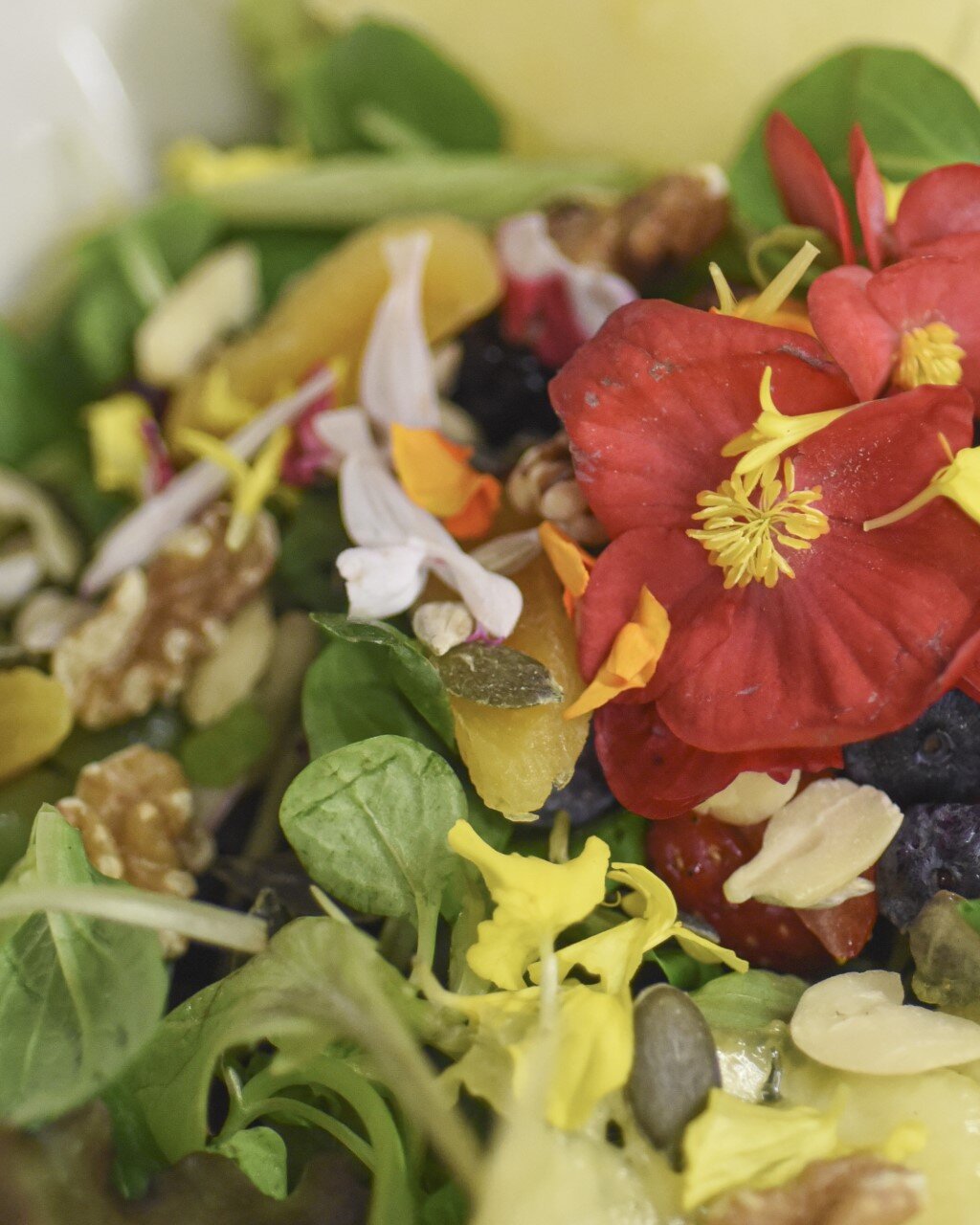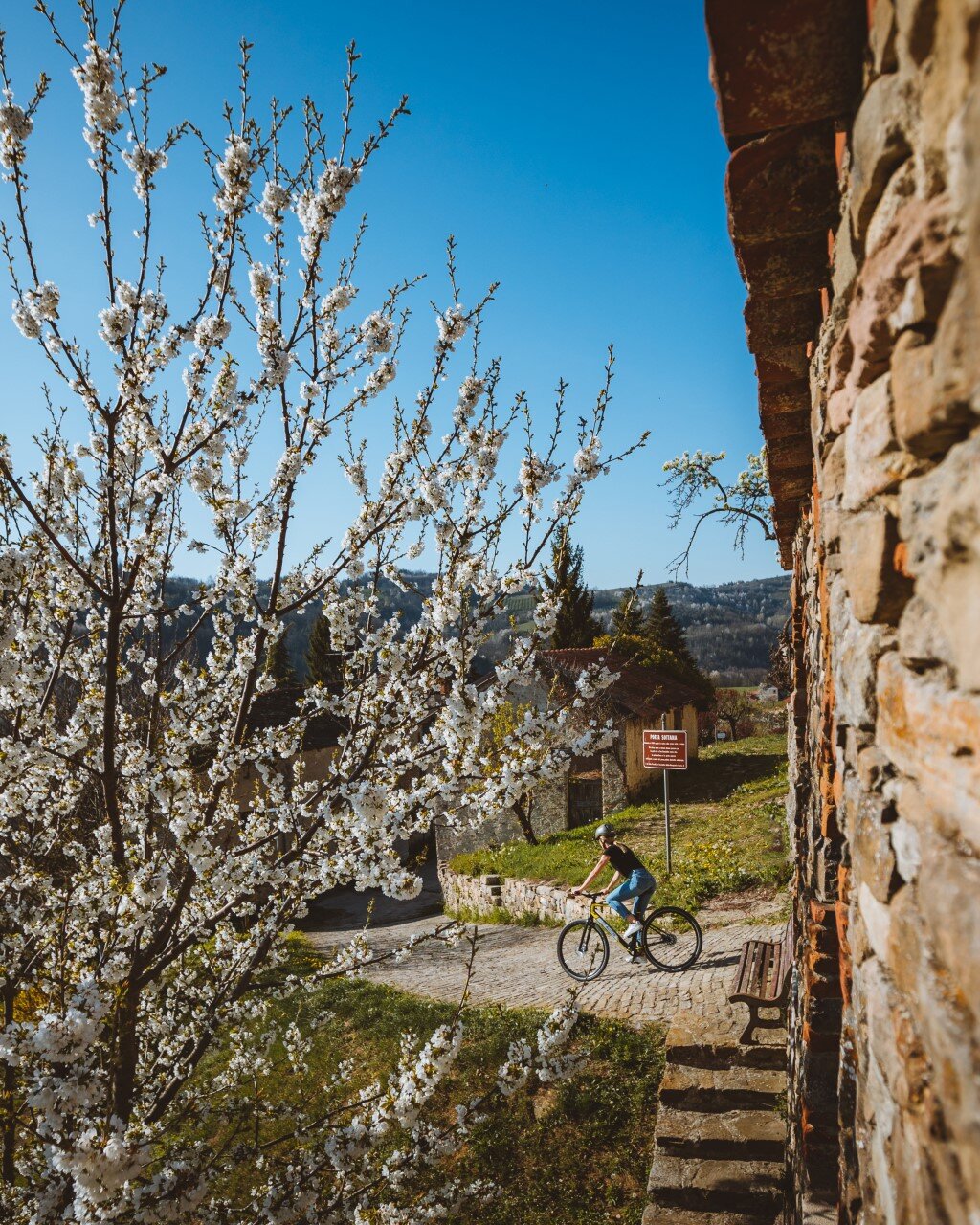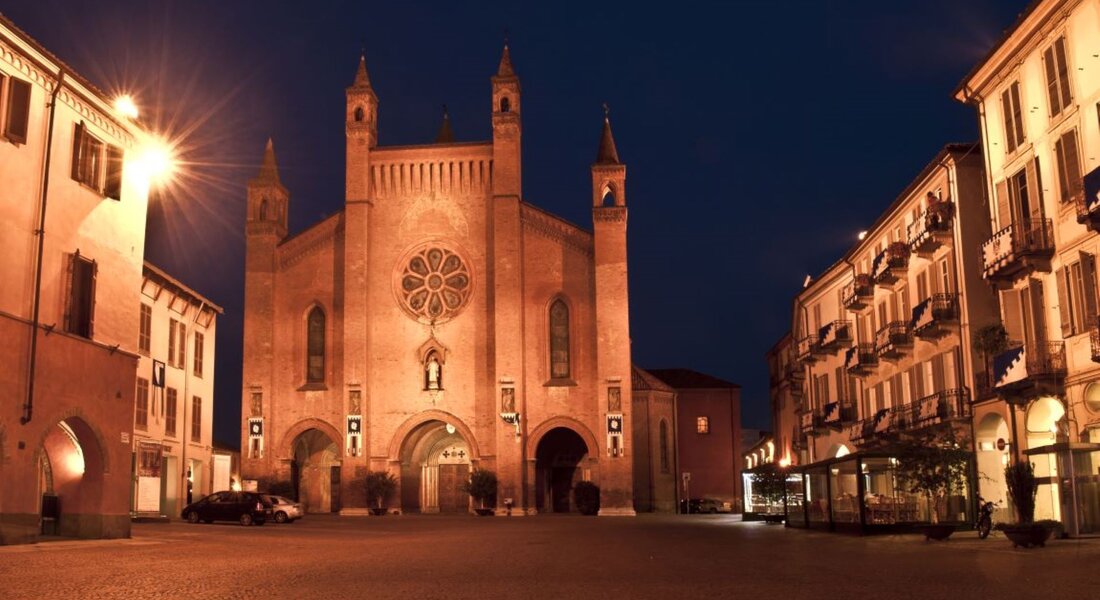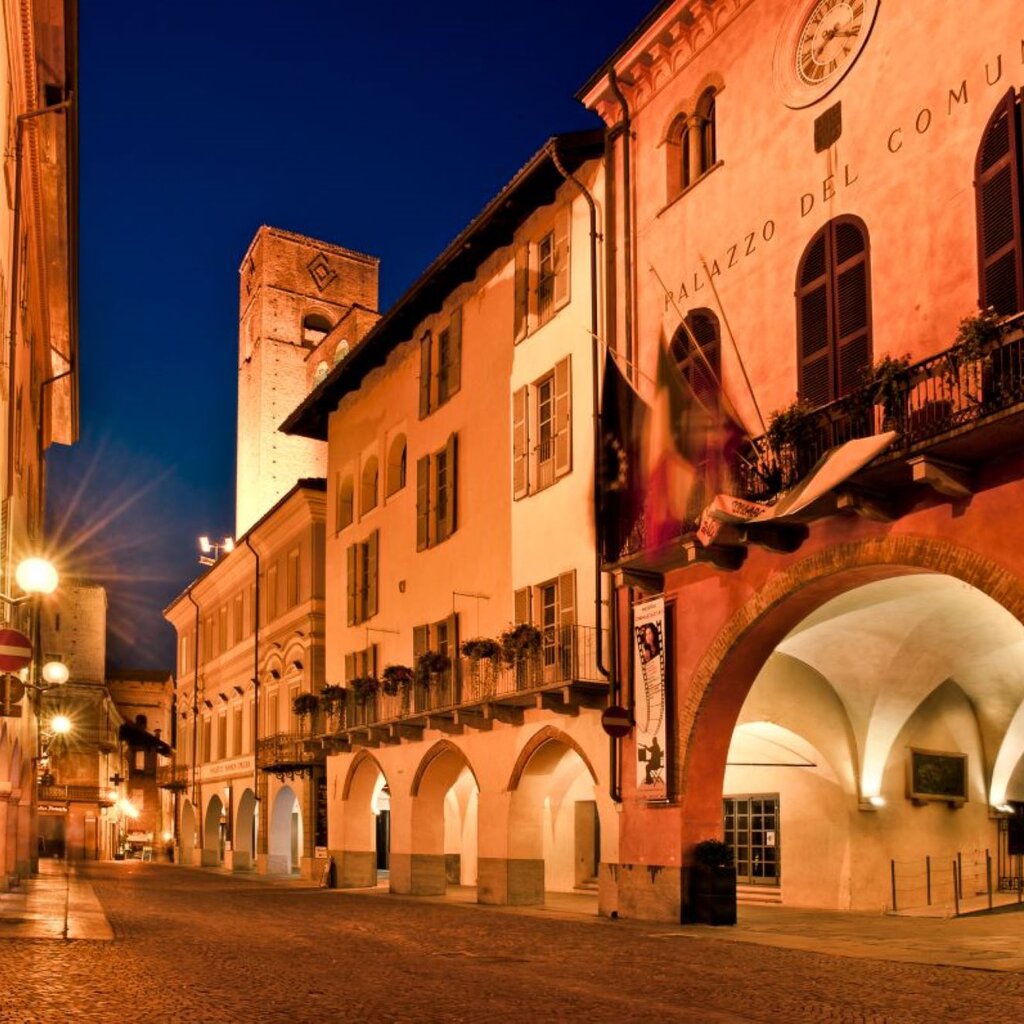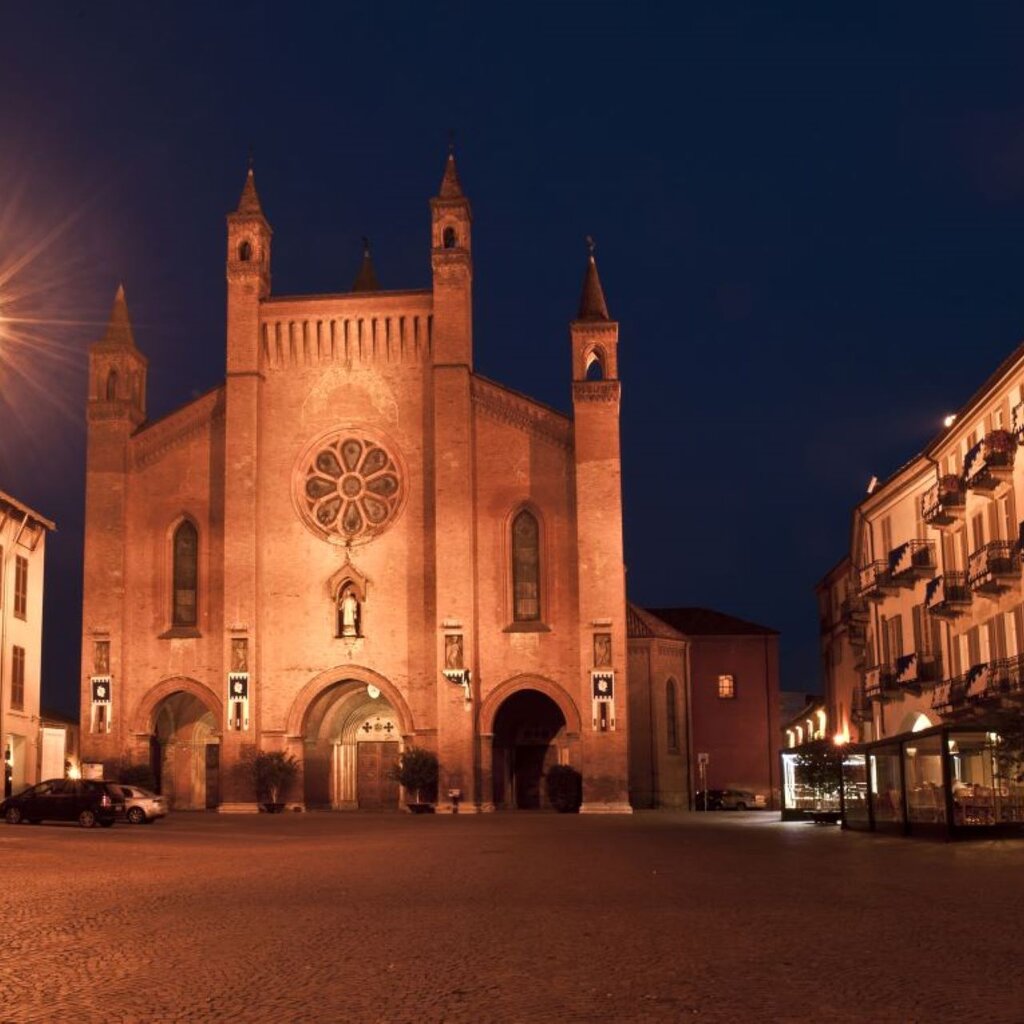However, almost all the archaeological routes are inevitably underground, since all the current buildings are based on a 2,000-year-old plan, which makes them perhaps even more attractive, in-between basements and cellars: from the Cathedral to the offices of the Tourist Board, from the Church of San Giuseppe to the historical headquarters of the Cassa di Risparmio. An archaeologist will take you by the hand and introduce you to the Roman city.
There is also, much more visible, the medieval Alba, which stands out among the few towers still reaching for the sky as well as the many other towers now confined to the roofs of the houses. To the keen observer it will be easy to see that the façades and corners of the buildings still preserve the symbols of ancient power. Back to the present day, here we are ready for our itinerary, which starts from the administrative and religious heart of Alba, Piazza Risorgimento, also known as Piazza Duomo, overlooked by the Cathedral of San Lorenzo and the Town Hall, with its tallest medieval towers. San Lorenzo is the result of several renovations (at least four churches were built on this square, and several Roman temples long before that), the most decisive being the one carried out at the end of the 19th century by Arborino Mella, based on Neo-Gothic styles and dictates. In chronological order, the first church was built in the 6th century and, apart from various ruins, has left us a very important baptismal font with an immersion basin. The second church was built around the year 1000 and, strangely enough, was already built with three naves meant to incorporate the early Christian font. The first bell tower also dates back to the 10th-11th centuries, while the current one, built all around the previous one which was used as a central pillar to support the access staircase, dates back to around the 12th century, as do its fine sandstone portals. An initial extension around the 12th-13th centuries is therefore conceivable. This involved the façade and the bell tower, on which it is sometimes possible to climb to enjoy a view of the city from a 40 m height.
Find out more
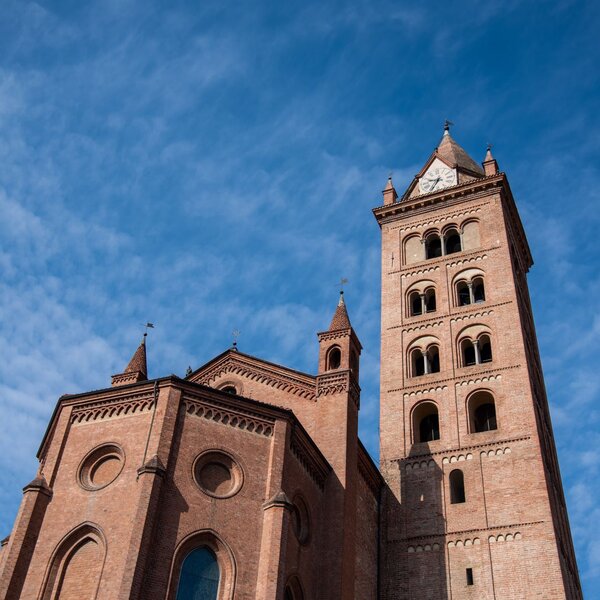
Alba, in white and red
Find out moreThe third church was originally built from the ground level (removing the portals and keeping the bell tower) at the end of the Middle Ages upon request of the city's great renovator, Bishop Novelli. It is a late-Gothic three-nave, Latin-cross structure with a portico and an elegant window on the façade in place of the current rose window. The cathedral has been remodelled several times over the centuries. However, it has never been remodelled in the same way as the architect Mella did in the mid-19th century, when he gave the church its fourth form, the neo-Gothic style. The architect redesigned the façade with its huge rose window, four pinnacles, niches with statues (symbolising the evangelists and the name A.L.B.A.), added the six side chapels and the polygonal apse, and, perhaps, enhanced the six columns connected with ogival vaults. The pictorial apparatus, mostly consisting of large canvases by local painters from the 18th and 19th centuries, does not boast any excellent signatures, nevertheless the Cathedral holds many surprises. First of all, the wooden choir made in 1512 by the Cremonese cabinetmaker Bernardino Fossati da Codogno; then, always in the apse area, the wood-carved statue of the Madonna of the Assumption, attributed to Antonio Roasio a native of the Mondovì area. The Chapel of San Teobaldo is also worth a visit, featuring a wealth of 18th-century paintings and a marble ark of the saint; right at the entrance there is a superb marble fountain dating back to 1503 and a large grandstand organ.
Finally, we recommend that you visit the Diocesan Museum in the Crypt of St Peter's (you can access it from Piazza Rossetti or from a door to the left of the presbytery), with an interesting collection of lapidaries ranging from Roman to late medieval finds. From the crypt you can then access the fascinating cathedral underground chambers, where you can read about the stratigraphy of the site and see the 6th-century baptismal font. A final pleasant note: the whole visit is accessible to everyone. Once we are back on the surface, we are back on the square, overlooked by the Town Hall since the 14th century, while the opposite porticoed buildings are more reminiscent of the Baroque, Umbertino and Art Nouveau styles (albeit on a solid medieval structure). And this is the fashionable side of the town, with its Piedmontese-style porticos, cafés, shops, terraces and restaurants. In the Town Hall, the beautiful Council Room is home to several masterpieces, including a Macrino. Next to the Town Hall are the offices of the Langhe Monferrato and Roero Tourist Board and, just past it, the Centro Studi Beppe Fenoglio (Beppe Fenoglio Study Centre) right inside the writer's house, featuring detailed documentation on the whole history of Alba; the extraordinary “Anticamera della morte” (Death Chamber) by Pinòt Gallizio can also be seen on the top floor.
Beppe Fenoglio, one of the greatest writers of the twentieth century, is actually from the Alba area. He wrote mostly about Alba and the Langa, narrating with the same avant-garde style the humble harsh lives of the peasants and the disenchanted heroism of the partisans. Fenoglio was the bard of the Langhe and - a partisan himself - the most authentic and genuine storyteller of the tragedies of the civil war. Also from Alba is one of the greatest painters of Situationism, the last of the 20th century avant-gardes. This idea, born almost as a joke, or perhaps just for fun, appealed to an eclectic and highly original pharmacist: Giuseppe - Pinòt - Gallizio, the father of Industrial Painting, and to Asger Jorn and Piero Simondo, the imaginative creator of revolutionary artistic visions. A visit to the Study Centre is therefore highly recommended, in order to fully immerse yourself in the essence of the hills.
Architecture-wise, the most interesting is the Sineo Tower (right in front of the Cathedral), 35 metres high and decorated with elegant triple lancet windows at the end. The Bonino tower (the slightly lower one standing on the corner with Via Maestra), on the other hand, has a curious stone string-course at about half height and simple round-headed openings on top. Finally, there is the 30-metre Astesiano Tower, also featuring simple arched windows and a striking double decorative lozenge on top.
The tower stands out on Via Cavour and is situated between the beautiful Palazzo Paruzza (headquarters of the Banca d'Alba, with a loggia tower), the opposite tower (at an angle and lowered) known as “della Farmacia” (of the Pharmacy) and the Loggia dei Mercanti of Casa Sacco, one of the best examples of 15th-century palaces in the town. In the initial part of Via Cavour the entire medieval fabric of Alba is preserved, and this continues in the nearby Piazza Pertinace. Today's square is the result of 19th-century demolitions, when many houses that "suffocated" the Church of San Giovanni were knocked down. Via Macrino once started from Via Cavour, while today it can only be found on the other side of the square: this explains the missing façades, porticos and the door "in the void" of the 15th-century Casa Riva. The Church of San Giovanni, despite being the oldest after the Duomo, has undergone numerous renovations, including the overturning of the façade: we can find traces of the surviving apsidal frescoes half-hidden by the organ loft at the right entrance. Today it presents a classic Piedmontese Baroque façade. From the 16th century it was an Augustinian church and convent and has inherited part of the works of the former nearby Church of San Francesco, which stood at the end of the homonymous square at the end of Via Cavour. Inside, San Giovanni holds a number of art treasures that are worth a visit, including a Macrino and a cycle by Gandolfino da Roreto (or d'Asti) and examples of fine wooden art.
Equally charming is the Casa-forte Marro which, although refined by a loggia on the top floor, retains the grim aspect of a city fortress: at the base are the foundations of a temple, which in Roman times overlooked the "piazza del foro", the forum square (always the cathedral square), well enhanced by a suspended path made of stairs and glass (the information board on site gives a more complete idea of the map of Alba Pompeia).
Via Cavour leads to the "Pontina" (Piazza Garibaldi) where the former romantic entrance to the city, with the historic Carlo Alberto bridge, has been lost. However, the view from the surviving ramparts to the north, in the large "cattle square" (Piazza Marconi and Piazza Prunotto) with the covered wing of the forum boario so common in Piedmont, is still pretty impressive. From here it is easy to get lost in the maze of alleyways around Via Manzoni (which leads back to the Duomo), passing by the baroque Church of San Giuseppe (you can also climb up the bell tower while in the basement you can see the remains of the Roman theatre). The façade of Casa Cantalupo-Paglieri, at number 5 Via Bosio, which connects Piazza Marconi with Via Manzoni, is particularly interesting and features 15th-century mullioned brick windows. Whereas if we decide to cross Via Manzoni and enter Via Balbo, we get into the priests' district (among Via Balbo, Via Giraudi and Via Como) where, apart from the city walls, most of the urban space is still occupied by religious properties. Beyond Via Balbo, we find Via Acqui which starts from the ancient Porta Cherasca (today's Piazza Monsignor Grassi) where an ancient wall still reminds us of the Roman gate, and the imposing structure of the bishop' s palace stands out (Alba, along with the cities of Asti , Vercelli and Acqui Terme, Ais one of the oldest dioceses in Piedmont. Via Acqui ends onto the historic "Piazza delle Erbe" (now called Piazza Rossetti and Piazza Miroglio), which is the area behind the cathedral.
The imposing medieval Palazzo Caratti-Govone, now well restored and occupying almost a block at the far end of the square, takes us back to the city's old parlour. In front of it, in fact, there is the massive lictorial building of the Civico Collegio Convitto (built in the 1930s to house the students of the oenological school, a renowned institute inaugurated in 1881 and one of the first in Italy) that along Via Generale Govone joins up with the Church of Santa Caterina, now used as an Orthodox temple.
We have now reached "piazza del teatro", the square’s theatre (also known as "dei piatti": Piazza Vittorio Veneto), where the theatre is one of architect Busca's most successful works. Completely restored at the end of the 1990s, the "Busca" Theatre was doubled with an original scenic solution that today sees the stage placed at the centre between the two halls, and is often used in this unusual guise.
Next, the square opens onto Via Calissano, with the Licelo classico “Govone, the classical high school and the church of San Domenico, which once formed a unicum with Santa Caterina and the other buildings in the area, which were all owned by the powerful Dominican order. The lyceum is more than just an ordinary provincial classical school: it is, in fact, where Beppe Fenoglio studied and where Pietro Chiodi, Leonardo Cocito and Giuseppe Petronio taught.
The church, built in the form of a basilica with a nave and two side aisles, is about 17 metres high and 50 metres long and has a large semi-decagonal apse. The impressive gable (the beautiful pediment that decorates the entrance with its curious three-lobed pointed arch and lunette) is found in the windows, arches and pinnacles of the façade and is amplified in the interior where 10 columns, decorated with the characteristic chessboard motif and fragments of frescoes of saints that are now almost illegible, stand out, imposing and solitary, leaving a considerable, very high "sense of void". A void that is then closed by ribbed cross vaults decorated with 15th century frescoes (many still lie under heavy Baroque plaster). The two restored rib vaults feature important paintings already in Lombard style, probably commissioned by Blessed Margaret of Savoy. In the apse, especially in the chapel on the left side, we find the best-preserved frescoes, some of which can be attributed to the Monregalese School.
The church, as it appears to visitors today, is very different from the original project: no trace remains of the division between the capella maior, designed for the monastic liturgy, and the outer church, where mass was celebrated for the congregation, except for a masonry structure that may correspond to the pier that separated the two sections (as it still exists in Vezzolano, see it. Romanesque in and around Castelnuovo Don Bosco. Major revisions were made between 1600 and 1700, when San Domenico abandoned its monastic dimension to become a parish church. During this phase, many frescoes were lost due to the architectural remodelling of the building. During the Napoleonic era, with the suppression of religious orders, the convent and church were considered simple public buildings and were used as shelters for troops and horses. With the Restoration, the church was reopened, but underwent further renovations. Restoration works only began in the early 1980s (and is still ongoing), thanks to the total commitment of the Famija Albeisa, the town's historic institution. Initially, it was financed only thanks to very large contributions from all the people of Alba.
On the esplanade in front of the church, once known as the piàssa dë scarpe (the shoe square: many squares in Alba took their slang name from the goods sold at the weekly market), you can see the lowered medieval tower of Casa De Magistris with its 18th-century portal; fine 15th-century windows also in the opposite Casa Deca, and less obvious traces can be found in other buildings in the area such as Casa Deabbate-Alliana and Casa Cagnasso. On the corner of Via Calissano and Via Maestra (officially Via Vittorio Emanuele II, but no one in Alba calls it that) stands the imposing structure of Casa Fontana-Do. It is one of the city's most intact medieval residences, enhanced by a series of terracotta friezes decorating the main stringcourse, above which you can still discern the two large windows that have now been blocked up and, above all, the 15th-century pointed arch loggia above it. The house also had its own tower, now incorporated into the building. So did the nearby Casa Stupino, just around the corner towards Piazza Savona (now called Piazza Ferrero).
Find out more
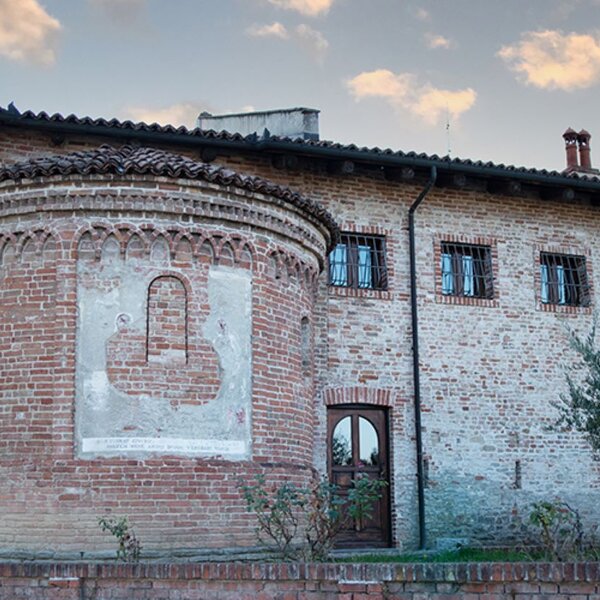
The hamlets of Alba
Just outside the old town, there is a kind of Alba that is unknown to most people because as it is outside the exquisite city boundaries. Historically, the city does not have the typical structure like the Asti’s hamlets, the “ventine, but there are some fine examples worthy of consideration. An unusual stop on the way to the Langa or Roero hills.
Find out moreAlong the stretch of Via Maestra that joins Piazza del Duomo (and which the Town Hall closes with a beautiful scenic effect), at number 6 is the medieval Palazzo Bergui (with pleasant trompe l'oeil and two large 15th-century windows in terracotta) and, at number 7, the home of the great art historian Roberto Longhi (also commemorated with a plaque). As you stroll along the elegant Via Maestra, you will see some of the noblest palazzos alongside the emblazoned shop windows displaying designer brands and truffles. For instance, the Conti Belli palace at number 16-18, dating back to the 16th century but built on a pre-existing structure, has a lowered stone tower and an important painted coffered interior. Next, along the widening with Via Belli, is the late-medieval house of the Counts of Serralunga, with a rare example of a Renaissance loggia in the courtyard, used as a model for the Casa d'Alba in the neo-medieval village of Turin. In this nameless little square (known as ''della Singer”, Singer's square, to the people of Alba), in the early 1940s, there was the first confectioner's shop owned by the Ferrero brothers, the very ones who made Nutella.
Further ahead, on the left, is the large Convent of La Maddalena with its homonymous Baroque church. The convent, founded in 1441 by Blessed Margaret of Savoy, now houses 21 rooms of the Museo Civico Archeologico e di Science Naturali (Civic Archaeological and Natural Science Museum) Federico Eusebio, featuring two collections: archaeology (stones and tombs from Neolithic and Roman Alba) and natural science (an overview of local flora and fauna). In the complex, there is also the "Giovanni Ferrero" library, the "Beppe Fenoglio" conference room and, above all, the large courtyard where the great Alba White Truffle Fair is held every year. The church has a central elliptical plan, the work of Piedmontese Baroque master Bernardo Vittone, and it seems to be a boudoir for noblewomen; not to be missed are the 15th-century wooden "Christ", the 18th-century inlaid choir with 48 stalls and the urn in which the relics of the Blessed Margaret of Savoy were kept for years (later they were transferred to the Dominican Convent in the hamlet of Madonna di Como). As for the exterior, the façade with its alternating bricks and sinuous Baroque forms (in the style of Palazzo Carignano in Turin) represents a Piedmontese unicum, although (or fortunately) it is unfinished.
Further on, past the Baroque Church of Saints Cosma and Damiano, the Art Nouveau Casa Varaldi at number 32 and the almost opposite Palazzo Mermet on the corner of Via Giacosa, with its tower, albeit remodelled, are also worth a visit. Here, on the canton do cine (corner of the cinema), the former Marchisio bookshop has been an intellectual meeting place for a long time, and the current business still preserves its remarkable coffered wooden ceiling, while in the nearby grocery store you can still find the smells and atmosphere of the last century. The stroll along Via Maestra combines elegant shop windows with some real "gems" from the beginning of the 20th century, such as the marvellous historic pastry shops; on the corner of Via Mazzini is the second Palazzo Bergui, an Art Nouveau masterpiece, with its elaborate bow-window overlooking the street.
Just a few steps from Piazza Ferrero, the Temple of St. Paul is certainly worth a detour. It is an imposing sacred edifice built by the Paolina family which was established in 1914 by Don Giacomo Alberione. The temple was opened for worship in 1928. The majestic bronze portal, made in 1964, is of great value and in the relief of the clappers it tells episodes from the life of St. Paul.
Then we are back in Piazza Ferrero. It was here that the famous pictures of the grape market were taken, with the square packed with carts and the café terraces crowded with sòȓa (swindlers) ready to clean out the naive and reckless people playing billiards, cards or gambling.
The temple of betting, however, was the Sferisterio Mermet (Mermet Sphaeristerium), which can be reached by turning right under the porticos (which continue all the way down Via Roma) and then enter the small Via Toti halfway through. It was here that the people of the Langa played elastic ball (nowadays known as pallapugno, in Piedmontese balon), their most popular sport. And here at the Mermet, rather than at the Umberto (Fenoglio's café), the Calissano ("the gentlemen's café") or the Savona (Giacomo Morra's kingdom, the hotel par excellence, but also a restaurant and billiard room) you could really lose your farmhouse, between business and the so-called tȓaverse (betting). The Mermet, which is still used for the Italian championships, is not just a pitch, it is a monument. It is the third oldest sports arena in Italy (and among the top 10 in Europe) and was founded in 1857, following the suspension of the game in Piazza del Duomo (where, however, a match is still played every year during the Truffle Fair). Great champions have played here and countless generations of sports reporters (such as Giovanni Arpino) and anonymous Langhe players have been here. Via Roma eventually ends along the railway station avenue.
